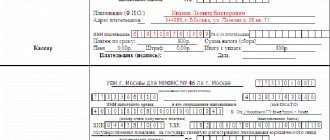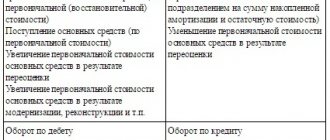Reliability of accounting
According to the Federal Law “On Accounting” dated December 6, 2011 No. 402-FZ, financial statements must be reliable. Reliability can be ensured by timely and complete reflection of the facts of economic life that correspond to reality.
In December, it is advisable to check the availability and correctness of primary documents and replace copies with originals. All transactions must be reflected in accounting and tax records.
If errors are found during the check and analysis, they can be corrected this year.
Do not forget to submit updated returns if the errors found led to an understatement of the tax base.
Inventory of property and liabilities
Before preparing annual financial statements, organizations must conduct an inventory of property and liabilities (clause 27 of the Regulations on Accounting and Financial Reporting in the Russian Federation, clause 38 of PBU 4/99). This must be done no earlier than October 1st.
It is allowed to check the availability of fixed assets once every three years.
Be sure to confirm accounts receivable and accounts payable. As a result of such a check, the commission must compare the accounting balances of the settlement accounts with the actual ones. To check with counterparties, you can draw up and sign reconciliation acts. But acts are not primary documents and are not required to be drawn up. The results of such an inventory must be reflected in the act in the INV-17 form.
Note! Not only accounts for settlements with customers (62) and suppliers (60), but also other accounts, in particular, 66, 67, 68, 70, 71, etc. are subject to inventory.
Based on the results of the inventory of settlements, debts with an expired statute of limitations are identified. Such a debtor and creditor must be written off from the register by issuing an appropriate order. The procedure for determining the limitation period is enshrined in Chapter. 12 of the Civil Code of the Russian Federation.
Particular attention should be paid to reconciling settlements with tax authorities and funds. Periodic reconciliation will help the organization avoid unnecessary fines and penalties, since payments are often suspended due to incorrectly specified details. Ideally, check with regulatory authorities quarterly after submitting mandatory reporting (declarations, payment of contributions).
We launch the “closing the month” procedure
Let's see how our turnover has changed.
I'll comment a little.
Look, account 26 at the end of the month was “closed” - it became 0. This is good. Here's a log of the wiring showing how it happened.
As we can see, expense accounts “transfer” their accumulated amounts from their Credit to Debit account to the financial result account. Remember the financial result formula? What accounts are involved?
So, Debit 90 and 91 accounts collect the expenses of our company for the current month.
Vacation schedule and staffing
Every year, the employer is required to approve the vacation schedule for the next year. This must be done before December 17 of the current year (Article 123 of the Labor Code of the Russian Federation).
From 01/01/2016 it is planned to increase the minimum wage (minimum wage). Let us remind you that now it is 5,965 rubles. If the enterprise has employees whose salary is close to the minimum wage, the staffing table will need to be revised. According to Art. 133 and 133.1 of the Labor Code of the Russian Federation, the salary of employees cannot be lower than the federal and regional minimum wage.
In case of salary increases, it is necessary to draw up additional agreements to the employment contract.
Reserves
Organizations are required to create a number of reserves in accounting (reserve for vacation pay, reserve for doubtful debts, etc.). Companies can also create reserves in tax accounting. As of December 31, you need to check the balances of all formed reserves. Depending on the type of reserve and the situation, unused amounts are included in income or transferred to the next year.
After checking the reserves for the current year, it is necessary to form reserves for the next year. If the reserve is not mandatory, the organization has the right to refuse to create it in the new reporting year.
Find out more in the article “Reserve for vacation pay: creation and use.”
How to determine a loss at the end of the year
Its financial result—profit or loss—depends on the production and economic activity of an enterprise. To obtain the final result, the main and other activities of the company should be taken into account.
Taking into account transactions during the year, the company makes entries to accounts 90 and , in which the amounts of income and expenses are accumulated, respectively. To identify the financial result at the end of the year, accounts 90 and 91 are closed. The company recognizes its activities as unprofitable at the end of the year; if the balance in account 90 is less than the balance in account 91, then expenses exceed income.
The loss is written off after closing accounting account 99. This operation is formalized by posting Dt Kt 99 (writing off the uncovered loss).
The loss indicator is cumulative . If there is profit from previous periods, the amount of loss can be repaid at its expense. If there is no profit, then the amount of the loss is summed up with the losses of previous years.
Change of tax regime
If an organization plans to switch to the simplified tax system, it is necessary to submit a notification to the tax office before December 31 (Article 346.13 of the Tax Code of the Russian Federation). The same requirement is established for persons who decide to change the object of taxation according to the simplified tax system.
Payers of UTII and simplified tax system must make sure that they have not lost the right to use the chosen system next year. The income of companies using the simplified tax system should not exceed 68.82 million rubles for 2020 (clause 2 of Article 346.12 of the Tax Code of the Russian Federation), and the residual value of fixed assets should be less than 100 million rubles. Organizations and individual entrepreneurs whose number does not exceed 100 people can apply the simplified tax system and UTII (clause 2.2 of article 346.26, clause 15 of clause 3 of article 346.12 of the Tax Code of the Russian Federation).
When switching from the simplified tax system to another taxation system, you must notify the Federal Tax Service before January 15 (clause 6 of article 346.13 of the Tax Code of the Russian Federation).
Sales of goods on account 90
First, let’s look at how, in general, sales are reflected in account 90, and what transactions need to be made.
If the sale being made is a regular activity of the enterprise, then accounting account 90 is used to reflect it (if this is a one-time sale, for example, the sale of a fixed asset, then account 91 is used, which is discussed in detail here).
Sales income is revenue; it is reflected on the credit of subaccount 1 in correspondence with the account for settlements with customers. (The topic of invoice correspondence was discussed in this article). That is, when shipping goods or products to the buyer, posting D62 K90/1 is made, which reflects the proceeds from this sale.
Sales expenses are collected in the debit of account 90.
The debit of subaccount 2 reflects the cost of goods and products sold.
In the case of the sale of goods, expenses are the costs of purchasing goods and the costs incurred during direct sale. The entry for recording the costs of purchasing goods has the form D90/2 K41, the entry for writing off sales expenses is D90/2 K44.
When selling finished products, the cost of production is written off to the debit of subaccount 2 using posting D90/2 K43.
According to the Tax Code of the Russian Federation, if an organization is a VAT payer, then value added tax must be charged on the products sold, the VAT charge is reflected by posting D90/3 K68.VAT.
Accounting entries:
Accounting policy
The procedure for maintaining accounting and tax records is fixed in the accounting policy of the organization (PBU 1/2008). The accounting policy is approved upon creation of a legal entity and is valid throughout the entire activity.
Every year, the accountant must review the adopted accounting policies to determine their compliance with actual accounting practices. If the organization's operating conditions or accounting methods have changed, it is necessary to review the accounting policies. Also, changes to this document must be made if new legal requirements appear.
Starting from 2020, the cost of depreciable property increases from 40 to 100 thousand rubles (amendments were made to Article 256 and Article 257 of the Tax Code of the Russian Federation by Federal Law No. 150-FZ dated 06/08/2015). If the accounting policy specifies the procedure for classifying depreciable property, adjustments should be made.
Notification of the Federal Tax Service on the procedure for paying income tax on separate divisions
Organizations that have several separate divisions in one subject of the Russian Federation can choose a responsible division and pay income tax for all divisions through it. The tax authority must be notified of this decision by December 31. Notifications are also submitted to the tax authority if the enterprise has changed the number of structural divisions on the territory of a constituent entity of the Russian Federation or other changes have occurred that affect the procedure for paying tax (clause 2 of Article 288 of the Tax Code of the Russian Federation).
Postings to account 99
Now we can calculate the financial result for each of them. Calculating the financial result is some kind of action on 90, 91 accounts. As you remember, accounts 90 and 91 after summing up the financial result should be equal to 0. And the final result of financial activity will be on account 99.
Zero balances for accounts 90 and 91 should be for the account as a whole. Sub-accounts of these accounts will have balances until December 31, pending the procedure - balance reformation. But more on that later.
This is how the situation looks in our SALT for accounts 90, 91 and 99. This situation arises after the “transfer” of expenses to account 90, BUT before closing 90, 91.
Look, I have highlighted key accounts from the entire SALT to show the intermediate stage of “closing the month”. We see that account 26 has been closed: its balances are zero. And, in our case, the amount of account 26 was displayed in the Debit of account 90.
In our example, the company has only account 26. If there were an account 44, it would also be closed and the amount from it would go to the Debit of account 90.
Thus, Debit 90 of account collects amounts from the company’s expense accounts, plus accumulates the cost of goods sold and products. Cost, as you understand, is available to manufacturing and trading companies. For us, only accumulated expenses from account 26.
Now we see that on accounts 90 and 91 different amounts were formed for Debit Turnover (DO) and Credit Turnover (CR). It turns out that for each of these accounts there is a final balance: 1705778.54 and 11374.53. Now it doesn’t make much difference for us where this balance is - in Debit or Credit. Only one thing is important to us:
Closing accounts 90 and 91 implies such actions so that the balance turns to zero. Those. we must make such entries for each account in correspondence with 99 so that our numbers - 1705778.54 and 11374.53 - go away. Those. the remainder would become zero. This is the rule for closing a total of 90 and 91 accounts - the balance on them should be zero.
And in order for the balances to become zero, we must transfer the existing differences between DO and KO (these are final balances) by posting to account 99. In other words, for account 90 we will “add” 1705778.54 to Debit. — for 91 accounts we will “add” 11374.53 to the Credit
The following report shows how we “add the necessary numbers” through postings, thereby closing accounts 90 and 91. The closure of these accounts will be correct if, after that, their balances at the end of the period (month) become 0.
As you can see, the closure of accounts 90 and 91 goes through their internal subaccounts 90.9 and 91.9 in correspondence with account 99. Where 90.9 (91.9) will appear in the Debit or Credit entry depends on where there are not enough amounts so that the account at the end of the period gives 0.
Conclusion Now we have looked at the very, very, very simple option of what “turnover” looks like and the principle of “closing the month” for companies providing services.
For trading organizations, SALT looks somewhat different. For example , we will see 41 and 44 counts. For production - there will be 20, 25, 40, 43, 44.
All businesses can have 76 and 73 accounts. In addition, many enterprises have 01 accounts with their own 02 and 08 auxiliary accounts.
All this diversity is not as complicated as it seems at first glance. Whatever accounting accounts you have to deal with in accounting, everything will come into “turnover”, where it will be necessary to take the amounts from all accounting accounts of Expenses and “move” them to accounts 90 and 91. Then from accounts 90 and 91, move the resulting balances to account 99. And so on every month until December. In December, there will be another operation called “balance sheet reform” at the “closing of the month.”
For the “closing the month” process, there is some more basic knowledge that affects the rules for transferring amounts to account 90. We look at all this in practical classes and learn how to solve such accounting situations from the event to the end of the month.
Addition The article raised questions, which was expected. Accounting is not a difficult subject, but all its numbers and rules make it difficult, confusing and confusing. The first questions showed that more clarification should be given to this article. The following article answers two important questions: - should more details be given in the SALT - in the SALT for account 26 there are different amounts - is this an error in the article?









